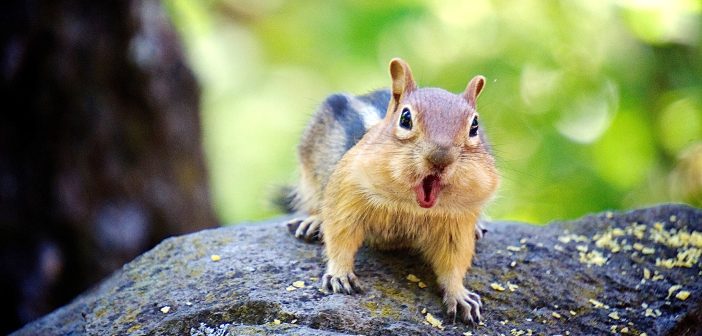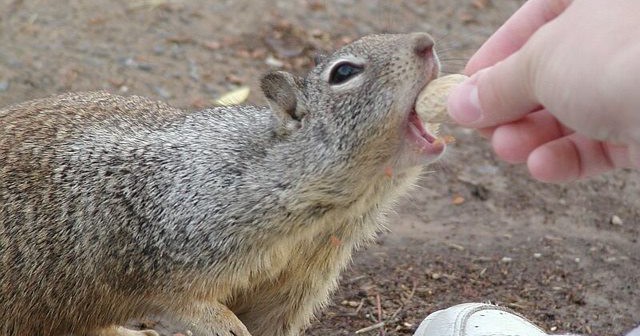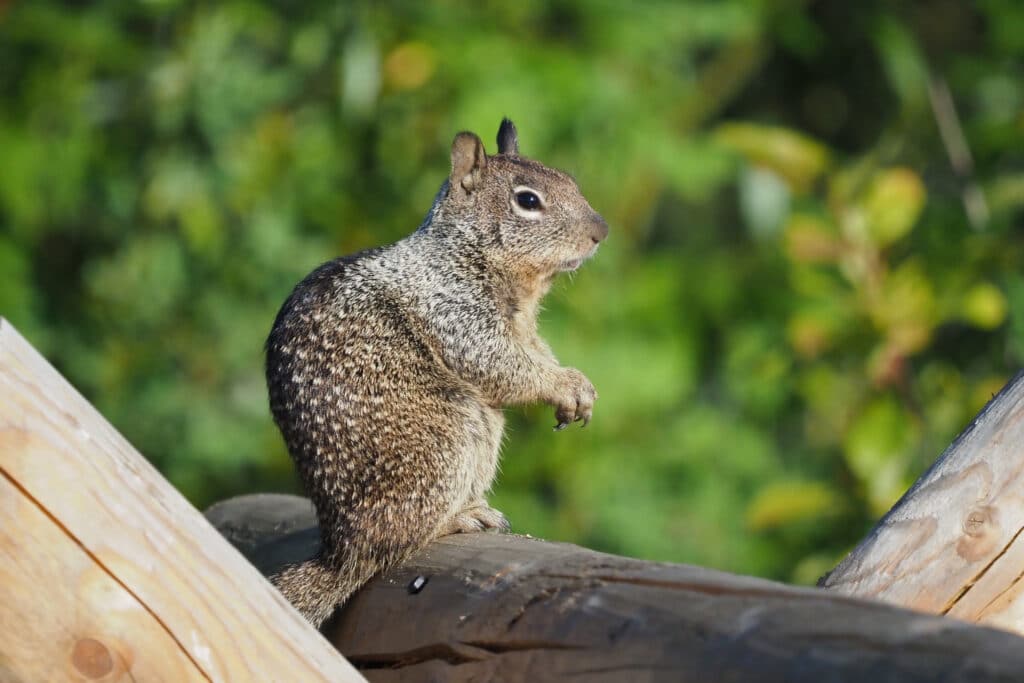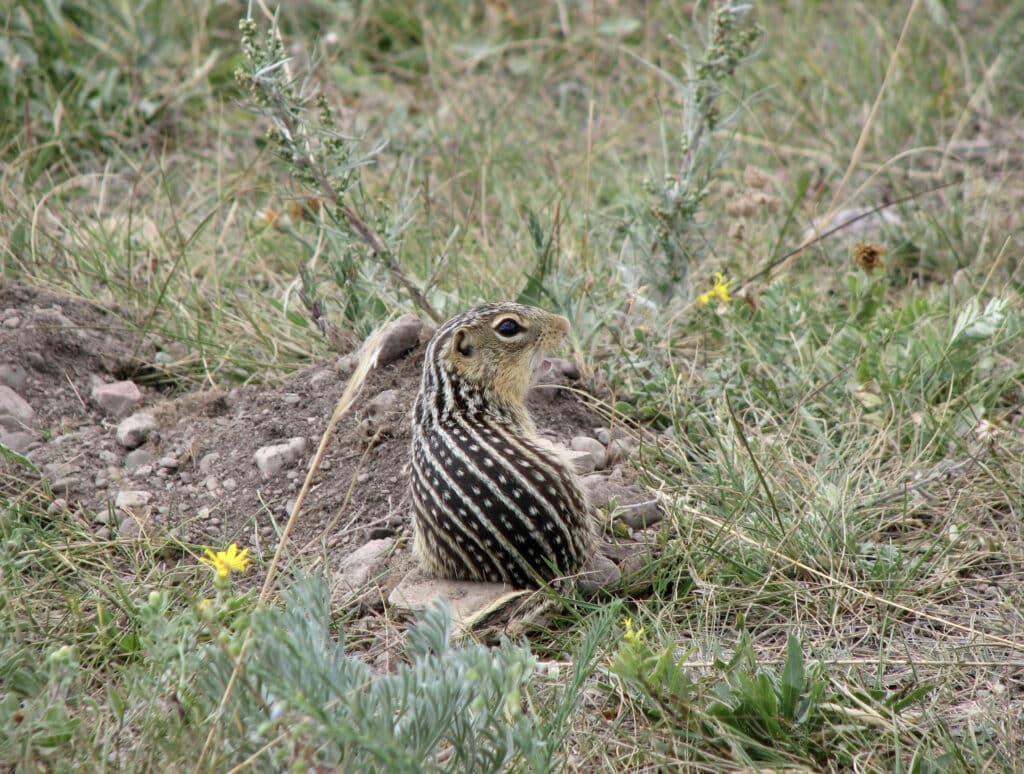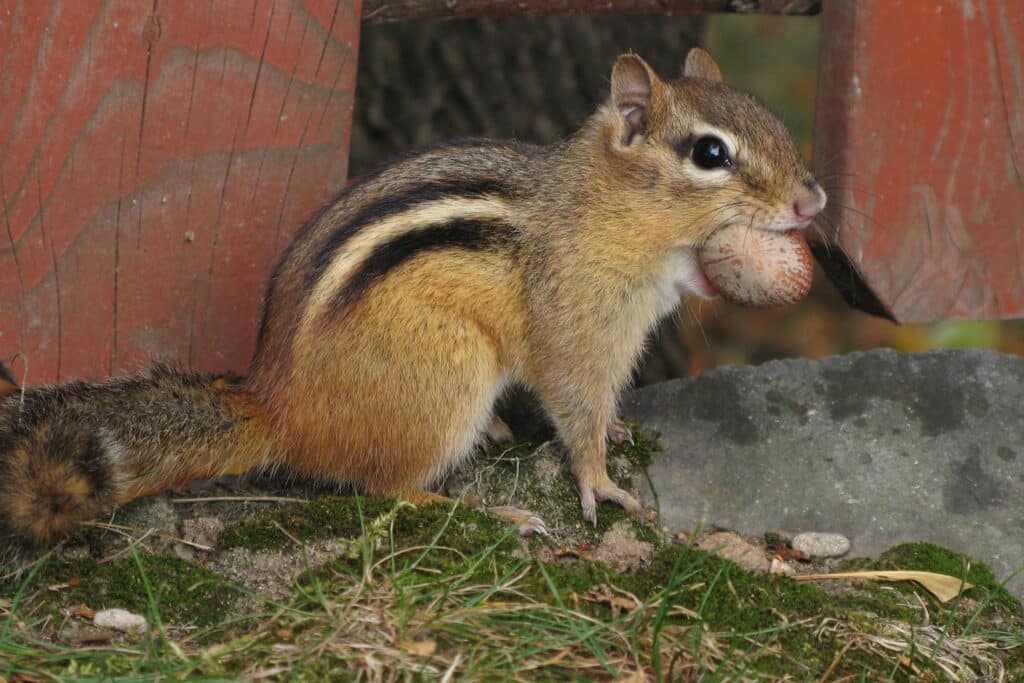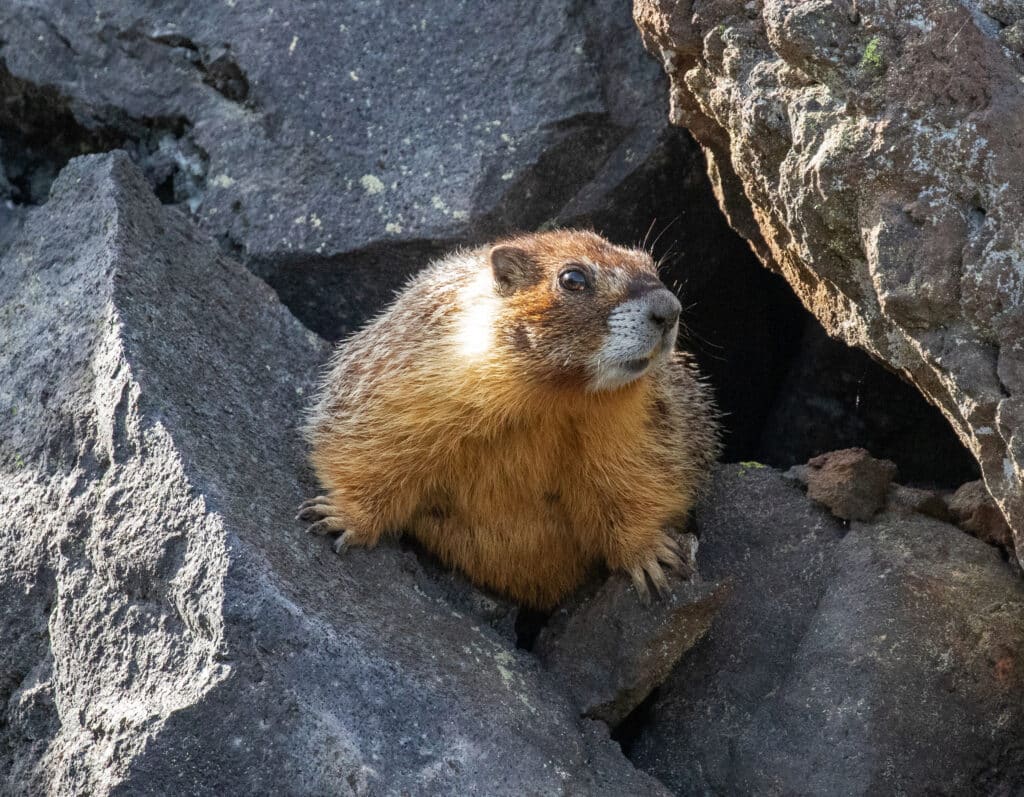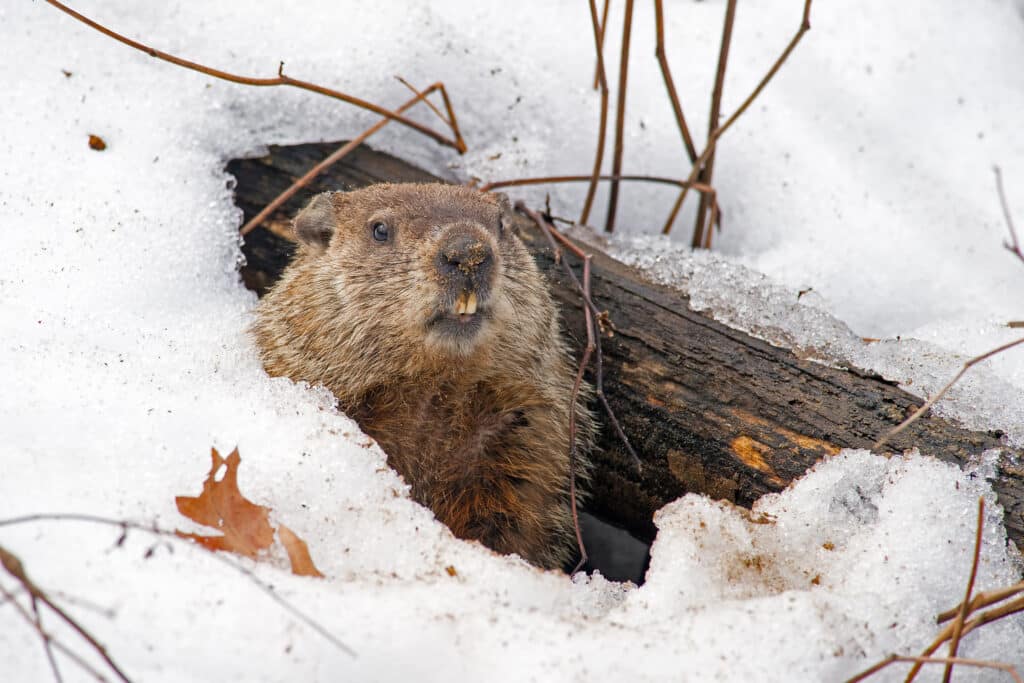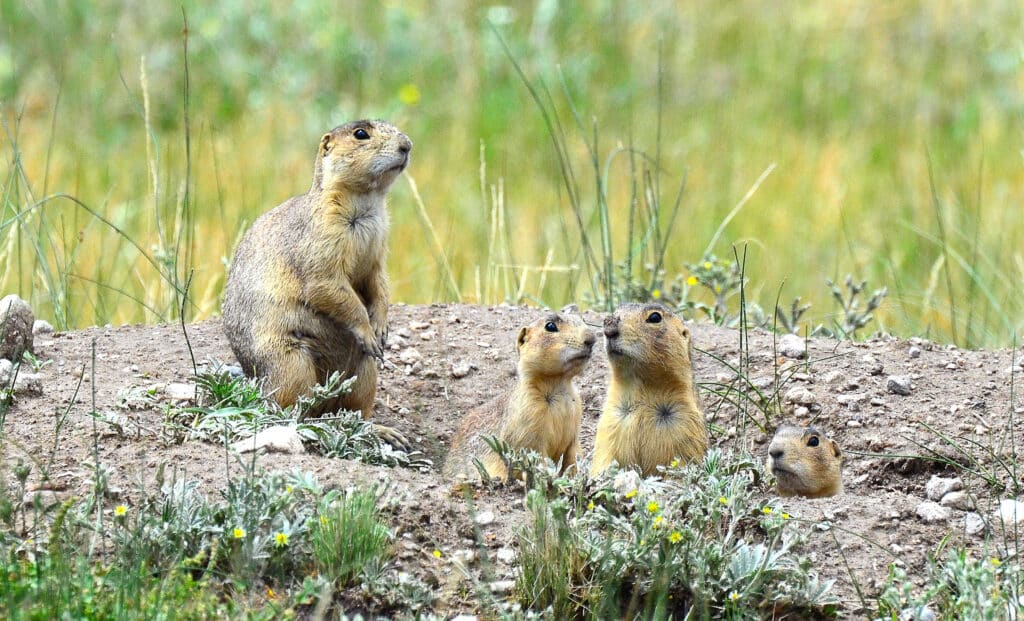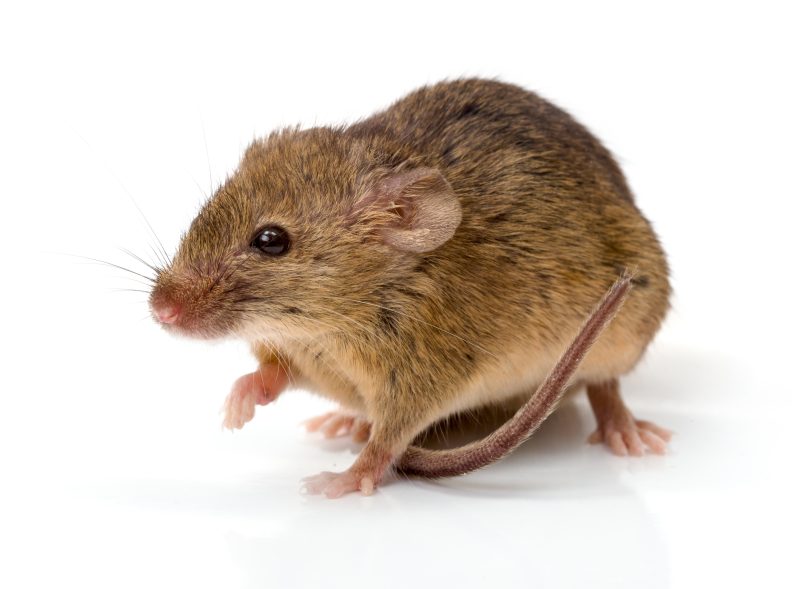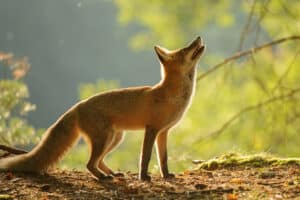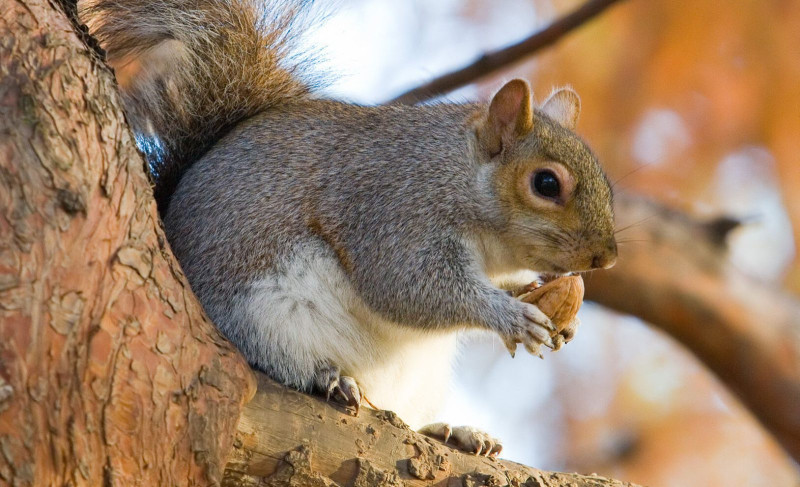Ground squirrels, in the taxonomic family Sciuridae, aren’t like their tree-dwelling relatives. They’re characterized by their terrestrial lifestyle. They spend much of their time on the ground or in elaborate burrow systems, which typically have several openings. Some species in this family are explicitly called “ground squirrels,” such as the California Ground Squirrel, Otospermophilus beecheyi, and the Thirteen-lined Ground Squirrel, Ictidomys tridecemlineatus. Other members are called by different names: marmots, chipmunks, and prairie dogs.
There are sixty-two species of ground squirrels in the world, thirty-eight of which are found in the United States. Ground squirrels are small to medium-sized animals distinguished by their stout bodies, short legs, and bushy tails. They’re well-adapted to a life spent primarily on the ground and have a history that traces back 40 million years to the Eocene Epoch. Originally arboreal, ground squirrels have evolved to thrive in a range of environments, from arid deserts to lush grasslands and rocky terrains.
Many farmers and ranchers want ground squirrels eradicated because of their tunneling and foraging. Researchers, however, believe they play an important role in controlling insect populations, seed dispersal, soil aeration, and providing habitat for other animals with their abandoned burrows. Ground squirrels are also important prey for hawks, foxes, weasels, and rattlesnakes.
General behavior
Ground squirrels are diurnal creatures, primarily active during the day and resting at night. Many species live in colonies or social groups of varying sizes, engaging in frequent social interactions and vocal communications. They construct intricate underground tunnel systems for shelter, food storage, and raising their young. Typically, ground squirrels have a breeding season that results in one or two litters per year, with the altricial young being born blind and helpless, requiring significant parental care. To defend themselves from predators, ground squirrels use their sharp claws and strong limbs for digging, and they remain vigilant, using vocal alarms to warn others of danger. In extremely hot and dry periods, many species enter a state of dormancy known as aestivation, while those in colder climates hibernate during the winter months.
(WelcomeWildlife.com wishes to thank the talented photographers whose wonderful photos enhance this page. Acquiring large numbers of photos is cost-prohibitive for a small site such as this, but these generous photographers offered their images free under Creative Commons Licenses or in the public domain. This allows us to provide informative content paired with captivating visuals.)
Ready to meet some of the most common ground squirrels in the U.S.? Here they are:
California Ground Squirrel, Otospermophilus beecheyi
One of the most common species in and around homes, the California Ground Squirrel is native to California and parts of Oregon and Nevada. They’re popular with people because they can be coaxed to come for food. However, in some areas, it’s now prohibited for fear someone may be bitten. Like other rodents, they must gnaw to keep their front teeth filed down. Otherwise, they’ll overgrow and become misaligned, which ultimately prevents them from being able to chew food properly. They starve to death when that happens. They don’t typically gnaw much on wood, but they’ll chew bark.
California Ground Squirrels thrive in open, sunny areas but also inhabit farmlands, orchards, forest edges, scrubby vegetation, and chaparral. Suburban areas are also inviting to them, where they make use of gardens, parks, and landscaped areas. Their favorite foods are dandelions, plantain, clover, and garden veggies. These ground squirrels can climb but prefer the ground. They live in colonies with multiple burrows interconnected by a network of tunnels, providing communal living spaces for them. Social interactions, such as grooming, play, and vocal communication, are common within their colonies.
In the wild, they typically live around three to six years. Predation and disease can significantly impact their lifespan, with many individuals not surviving past their first year. In captivity, they can live longer, sometimes up to ten years.
Douglas’s Ground Squirrel, Otospermophilus douglasii
The Douglas’s is a native species found in the western U.S., particularly in California and Oregon. They prefer forested and shrubby areas and rocky outcrops, often at higher elevations, but are also commonly found near homes and gardens wherever they find the habitat suitable. They eat various fruits and berries when they’re in season, as well as leaves, grasses, herbs, insects, small invertebrates, and occasionally bird eggs. In forested habitats, they sometimes eat fungi, including mushrooms.
The Douglas’s are terrestrial and live in burrows, but they may not create as extensive tunnel systems as the California Ground Squirrel. They’re less social, too, and may live in smaller, less social groups compared to the former. Smaller and more slender than the California Ground Squirrel, their fur tends to be more uniform in color, typically a mix of brown and gray, with less mottling than the other.
In the wild, they typically live around three to seven years. Predation, disease, and habitat quality significantly impact their lifespan. In captivity, where they’re protected and cared for, they can live up to ten years.
Thirteen-lined Ground Squirrel, Ictidomys tridecemlineatus
This native species, also called the Striped Gopher, Leopard Ground Squirrel, and Squinny, is the most common ground squirrel in the central U.S., particularly the Great Plains. They prefer open grassy habitats such as prairies, fields, and suburban lawns. Easily recognizable by their distinctive pattern of thirteen alternating light and dark stripes running along the back and sides, they’re diurnal and primarily solitary, though may live in loose colonies. Their diet includes a variety of seeds, nuts, fruits, insects, and occasionally small vertebrates and bird eggs, making it an opportunistic feeder.
The Thirteen-lined Ground Squirrel is known for creating extensive burrow systems for shelter, food storage, and raising young. It hibernates from late fall to spring, emerging as temperatures rise and food becomes more plentiful. During hibernation, its body temperature can drop as low as just a few degrees above freezing.
In the wild, they typically live four to five years, although many do not survive past their first year due to predation and other factors. In captivity, they live up to seven or eight years.
Chipmunks
Chipmunks are ground squirrels in the genera Tamias, Eutamias, and Neotamias. In total, there are twenty-five species and subspecies in the world. Twenty-one of them inhabit the continental U.S. and Alaska, and several of them are native. They’re cute and fun to watch, so many people welcome them into their yards. They can be destructive, though, by munching on plants and flower bulbs and digging numerous tunnel entrances. However, they’re also beneficial: they eat small rodents, spread seeds and fungi spores, and eat grubs and other insects. They spend most of their time on the ground and live alone in underground burrows, but they’re also good climbers and can be seen in trees.
Chipmunks thrive in a variety of habitats, including forests with plenty of trees and underbrush, woodlands and shrublands, grasslands, meadows, rocky areas, and urban and suburban settings. Some live in mountainous habitats wherever they can find ample food and cover.
The Eastern Chipmunk, Tamias striatus, is a native species that is one of the most widely distributed chipmunks in the U.S. and the only ground squirrel that inhabits the eastern half of the country. In winter, they hibernate, but not deeply, and they sometimes leave their burrows on warm, sunny days. When hungry, they rely on a cache of food they store ahead in a separate chamber in their burrow. Most emerge from hibernation in early March.
In the wild, Eastern Chipmunks typically live two to three years, although some individuals can live up to five years. In captivity, where they’re protected from predators and have access to consistent food and medical care, they often reach up to eight years or more.
Pocket Gophers, family Geomyidae
“Gopher” is a common name for various species of ground squirrels, but pocket gophers aren’t among them. They actually belong to a different family of squirrels. They’re named for their large cheek pouches, or “pockets.” The pockets are fur-lined and can be turned inside out! The gophers stuff them with food to transport back to their burrows. These animals are “larder-hoarders.” That means they store food at a single location—sometimes in huge amounts—to eat when food is less plentiful aboveground. (By comparison, tree squirrels are “scatter-hoarders” that hide their food in many places.) Pocket Gophers are native throughout the U.S., Mexico, and Central America. Most have brown fur that matches their habitat. If these guys move into your yard, you’ll know it! They leave mounds of dirt in their wake.
In the wild, pocket gophers typically live one to three years, although some individuals can live up to five years. In captivity, five to seven years.
Marmots, genus Marmota
Marmots are larger than other ground squirrels, weighing 5 to 15 pounds (2.3–6.8 kg). There are fifteen recognized species worldwide, six of which inhabit N.A.
Marmots are highly social and live in colonies with complex social structures, communicating through a variety of vocalizations like whistles and chirps. Unlike many ground squirrels, marmots hibernate for six to eight months. Their burrowing activities are more extensive than other ground squirrels. They create complex underground systems that provide shelter, food storage, and protection. Their preference for high-altitude, mountainous habitats also sets them apart from other ground-dwelling squirrels.
Marmots primarily eat an herbivorous diet consisting of grasses, forbs, and flowers, but they may also consume fruits, seeds, and insects. Their habitat includes mountainous regions, alpine meadows, and rocky outcrops, where they dig extensive burrow systems for shelter and hibernation. Marmots benefit their ecosystems as their burrowing activity aerates the soil and promotes plant diversity. Additionally, they serve as prey for various predators, contributing to the ecological balance.
The Yellow-bellied Marmot, Marmota flaviventris, is the most common U.S. species. They’re widely distributed across the Rocky Mountains and the Sierra Nevada, ranging from Colorado and Utah to California and Oregon. They’re often seen sunning themselves on rocks and are known for their loud whistling alarm calls, earning them the nickname “whistle pigs.” They typically live in colonies of several family groups. Each usually includes a dominant male, multiple females, and their offspring. Their lifespan is about thirteen to fifteen years, and longer in captivity.
Groundhog (Woodchuck), Marmota monax
The Groundhog, also known as the Woodchuck, is one of fourteen species of marmots. “Woodchuck” is from the Algonquin name for it, “wuchak.” They’re widely distributed across the eastern and central U.S. They thrive in areas that offer a combination of open land for foraging and safe places for burrowing, such as open fields, meadows, agricultural lands, forest edges, and hilly or rocky areas, which provide good drainage and stability. They also reside in urban and suburban environments, such as parks, gardens, and green spaces. Mostly solitary, their burrows have multiple entrances and chambers for nesting, sleeping, and food storage.
One of the few animals that go into true hibernation in the winter, they dig their burrows below the frost line and lower their body temperature to 39°F to 40°F (3.8–4.4°C). They emerge from March to April (earlier in warmer areas).
You’ve likely heard this old tongue-twister: “How much wood would a woodchuck chuck if a woodchuck could chuck wood?” It’s said in fun, but it seems there’s an actual answer: Cornell University says a wildlife biologist measured the inside volume of a woodchuck burrow and estimated that 700 pounds (318 kg) of dirt had been chucked out of it. So he concluded that’s how much wood a woodchuck would chuck if it were chucking wood!
In the wild, groundhogs typically live three to six years and up to nine under favorable conditions. In captivity, where they are protected from predators and have access to regular food and medical care, groundhogs can live longer, sometimes up to fourteen years.
Prairie Dogs, Cynomys spp.
Prairie Dogs are five native species that inhabit grasslands and prairies of the Great Plains and Mexico. They were named by early settlers, who thought their calls sounded something like barking dogs. Very social, they live in family groups called coteries, which usually contain an adult male, one or two adult females, and their young offspring. The coteries are grouped into wards (neighborhoods). Several wards make up a colony or town. The animals often greet one another by touching each other’s teeth, which gives the appearance of kissing.
Black-tailed Prairie Dogs, Cynomys ludovicianus
Black-tailed Prairie Dogs were once extremely common across the Great Plains of the U.S., ranging from southern Canada to northern Mexico. At one time, they were possibly the most abundant mammal in N.A. They’re still the most common prairie dogs. However, their populations have been reduced by 95 percent due to human eradication efforts. They compete with livestock for grass, eat crops, and disturb soil.
They have complex calls to warn others about predators: what they are, how big they are, and how fast they’re approaching. Professor Con Slobodchikoff has done an extensive sound analysis of their calls and says the animals describe a human walking through their town essentially like this: “Here comes the tall human in the blue (shirt)” or “Here comes the short human in the yellow.”
In the wild, they typically live around three to five years. However, under optimal conditions with fewer threats, some individuals can live up to eight years. In captivity, they can live eight years or more.

